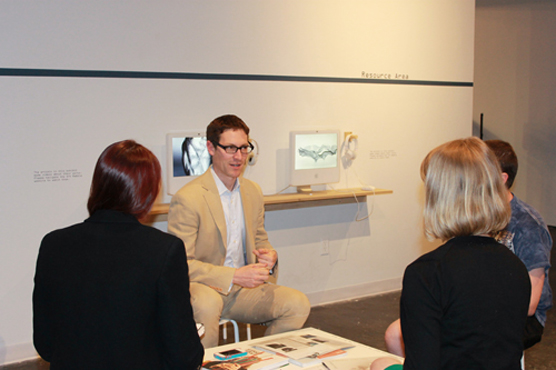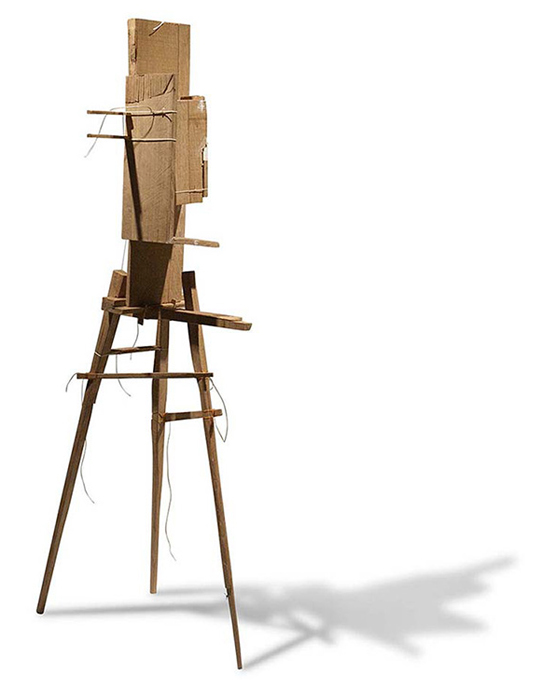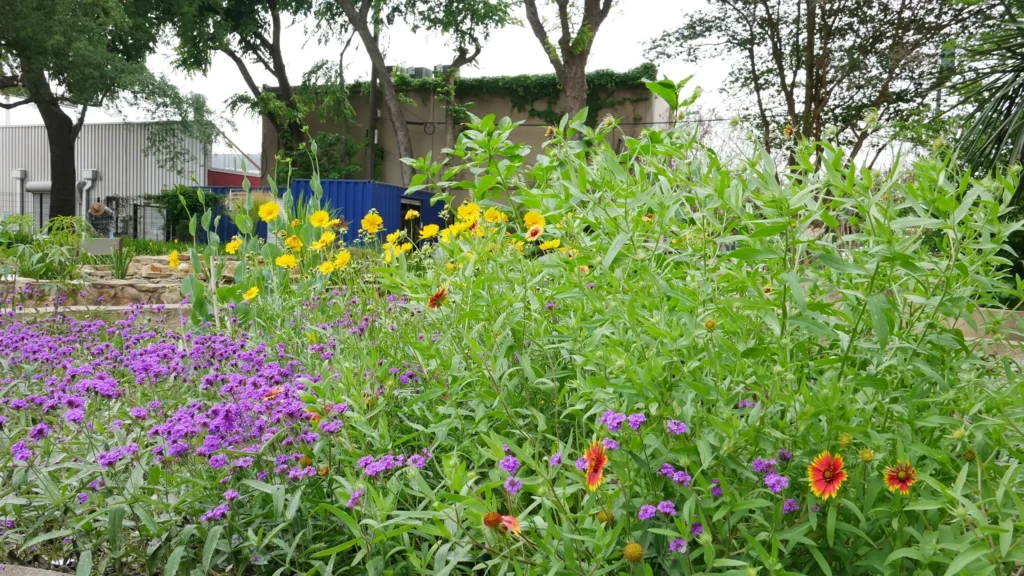
Earlier this month, HCCC hosted Ethan Lasser, curator of the current exhibition, The Tool at Hand, for a members-only exhibition tour and reception. Lasser is the Margaret S. Winthrop Associate Curator of American Art at Harvard Art Museums’ Division of European and American Art. He is also the former curator of the Chipstone Foundation in Milwaukee, Wisconsin, where he organized The Tool at Hand. HCCC curatorial staff, Ashley Powell and Quinn Hagood, had the chance to briefly interview Lasser during his whirlwind 24-hour trip to Houston.
The general public may not be familiar with how an exhibition is conceived and organized. Can you tell us about your inspiration for this project, and, inevitably, how the exhibition came together?
This exhibition came out of my work as an art historian. I work on the 18th century, and I was writing about “Portrait of Paul Revere” by John Singleton Copley, a painting that is about an artist and his tools. I was really interested in the treatment of the tools, which are carefully rendered, crisply detailed. It was clear to me that the painter was saying something about the silversmith and his tools, and I was trying to get at what that might be. Then I started reading that in Colonial America, if you’re an artisan, and you’re sued for debt, the last thing that gets taken from you is your tool kit, which is kind of interesting and speaks to this intimacy between makers and tools.
But I noticed that there wasn’t much writing about how artists thought about their tools, and this exhibition was a way to explore and research a question that percolated out of a historical question for me, which was, “Are tools friends or enemies?” “Are they part of you or not part of you?” We know a lot about how makers think about their materials, but I wanted to introduce this other point on the triangle of making–maker-tool-material–and what’s the tool’s role?
Then I thought about people I knew and people I’d heard about who are also interested in this question, and I tried to get a variety of different materials represented. We didn’t want it to be a normal thing, and, because this idea was so eccentric, we sent a short film to a group of artists as an invitation to participate in this challenge. They just got a CD in the mail, with no letter. I was shocked because everyone watched it, and only two people said, “No.” One guy said, “I just couldn’t do it. I couldn’t abide by this.” Someone else just couldn’t do it for more logistical reasons… We wanted and were hoping for eight, because we expected a lot of artists to say, ”No,” but 16 said, “Yes.”
From a curatorial position, not knowing what the artists’ results of this project would be, how did you select the artists that were invited? Did you have certain criteria?
The criteria were people who are already engaged, in some way, with this question of “What’s my relationship to my tools?” and trying to get people across media. This exhibition features an international cast, which was important to me; I wanted to show people who had not been shown in the United States before. Also, the project was born when I was a fellow living in London for a year, and through conversations with people, so I had this group that was already thinking about this.



You are obviously familiar with each of these artists and their work, and I’m curious about whether or not there are any pieces in the exhibition that were big shockers when you saw them for the first time or that you were particularly surprised by.
Yes, it was interesting. I picked people, and some people did what I picked them for, and other people were totally out in left field. Michael Eden made what he always makes. David Gates, the woodworker, made what he always makes, under a constraint. But, for example, the caulk piece by Beth Lipman was a total shock. I picked her because she works in glass, and her work is normally very pretty, and she did something entirely different. She worked with a different material, a very different look, a total experiment. I knew it was happening, but when it arrived, I thought, “Whose is this? What is this thing?” It also hadn’t cured yet, so I’m only seeing what’s inside it now for the first time. Her work arrived in December of 2011, and it was a white, solid mass that slowly started to cure. Now, you can really see inside it, and it is very much like a living thing.


So, what do the results of this experiment say to you about the relationship between an artist/craftsperson and the tools he/she uses?
I think there are a lot of different answers to that question in this exhibition, from people who were very literal about what this constraint was and tried to pair down what they do and really tried to investigate, “Is this thing, is this one tool really doing what I want it to, or is it working against me?” to others that took this as a chance to be more improvisational. I think they came to see that the constraint in their relationship to the tool is quite different than when they are in their studio and have access to things like–in the case of David Gates–80 chisels, just chisels, for every mark he wants to make. He has a highly specialized toolkit, as every woodworker has, so for him, it was a chance to be more improvisational and to wrestle with his tool a lot more than he normally did. I think the big thing that came out is this relationship to industry that I didn’t even know was going to happen at the beginning of the show. One of the essays on the website is about an interview with factory workers who are dealing with one tool for eight-to-ten hours a day, day after day. And, in some ways, what’s happening in here is very different, and there are interesting parallels between what the artist had to do and what someone in industry does, in terms of intimately knowing one thing.
What were some of the challenges you faced while putting “The Tool At Hand” together and organizing it?
It was interesting not knowing. Usually, I do shows of dead people, right? This was different for me, because I had to negotiate with 16 people, but, more importantly, I didn’t know what was coming. I had a sense people would make certain things, and they didn’t, which was a good challenge in a way. Or, a work arrived, and I had issues with it, either with the way it engaged with the constraint or with it as a thing, and I had to lay that aside for the sake of the experiment. So, all of that was different for me.
Several of the artists in this exhibition used computers and their associated technologies in their artistic process. Creating a physical manifestation of a digital design requires an artist to choose an output method from a computer, whether that’s a 3D printer or a CNC machine. Do you think that these artists consider the output methods, such as the 3D printer, rather than the computer itself, as the tool?
You’re talking about Chad Curtis and Michael Eden, maybe others. No, I think that for this work, for Chad Curtis, who thought about the tool in a very conceptual way, the tool was information, and so he started with a set of numbers and gave them form, but the given form didn’t matter to him so much as the information. I had a good debate with Michael Eden about this, because he wasn’t dealing so conceptually, necessarily. He is someone who has worked as a studio potter for 20 years, and he abruptly shifted to 3D printing. He felt that, just as drawing was part of his studio practice and, in a way, more fundamental than executing a form on the wheel, so, too, was his sketching on the computer, more crucial to his work. A good thing that came out of this show is that it is a show of contemporary art, and everyone can get the premise, and that’s good and bad. Because some people just judge it on the grounds of, “Did they play by the rules?” Whereas, others, for example, Chad, were trying to get into, “Well, what is a tool? What counts? Does it have to be an instrument that works with material in some way? Can it be something more abstract?”
Like the tool actually being the hand itself…
Yeah, which is what Hongtao Zhou was trying to do. Although, his tool was also the crowd, because he had close to 30 people making that chair, which is why I was saying you guys could re-build it as a performance. On his video, my hand is in there; we did it as a group.
Part of that messiness was deliberate, because I wanted there to be a debate about, “What does it mean and what counts?,” and I think people respond to that in different ways. Maybe your question gets to the heart of that debate in some way. We didn’t emerge from this with a clear definition of what a tool is, but every artist came up with that in his or her own way.

What are your theories about the future relationship between craft and technology?
This show is split on that because you have people doing very old-fashioned things, and people who are not. But what I was saying before is that one of the things that came out of this was this conversation between industry and art, factory-making and art-making. Factory-making being the site where technology is often deployed, and I think that one way this will evolve is that you’ll see more collaborations. In some ways, Chad’s work and Michael’s work are collaborations between art-making and industry, because they dispatched their ideas like the ‘60s minimal artists did to get their ideas fabricated. So, I think that you’ll start to see more of that, but I also think the hand will always have a place. For example, Chad finished those (Untitled, plywood, 2011) and Michael goes in and sands his pieces, so it will never be lost. This show is also probing, “What’s different about tools now that we have computers?”
